A regular single-day Spring Tour in North Norfolk today. It was cloudy all day, a bit brighter in the afternoon, with thankfully nothing more than a few light spots of drizzle in the middle of the day, and feeling a bit milder today in the lighter N wind.
Our destination for the morning was Choseley but on our way there we drove round past some old barns. The Little Owl was not in its usual place this morning, but one of the group spotted it as we were driving off, perched further round on a wooden board across a window opening in one of the buildings. After a quick turn around, we had a great view of it from the minibus before it flew inside out of view.

When we arrived at Choseley, the Dotterel were running around in the stony field where they have been for the last couple of weeks. We had a good view of them through the scope. We counted six of them together, a mixture of bright females and duller males – Dotterel are one of those few species where the sexes are reversed and the females are brighter and the males do most of the incubation and rearing of the young.
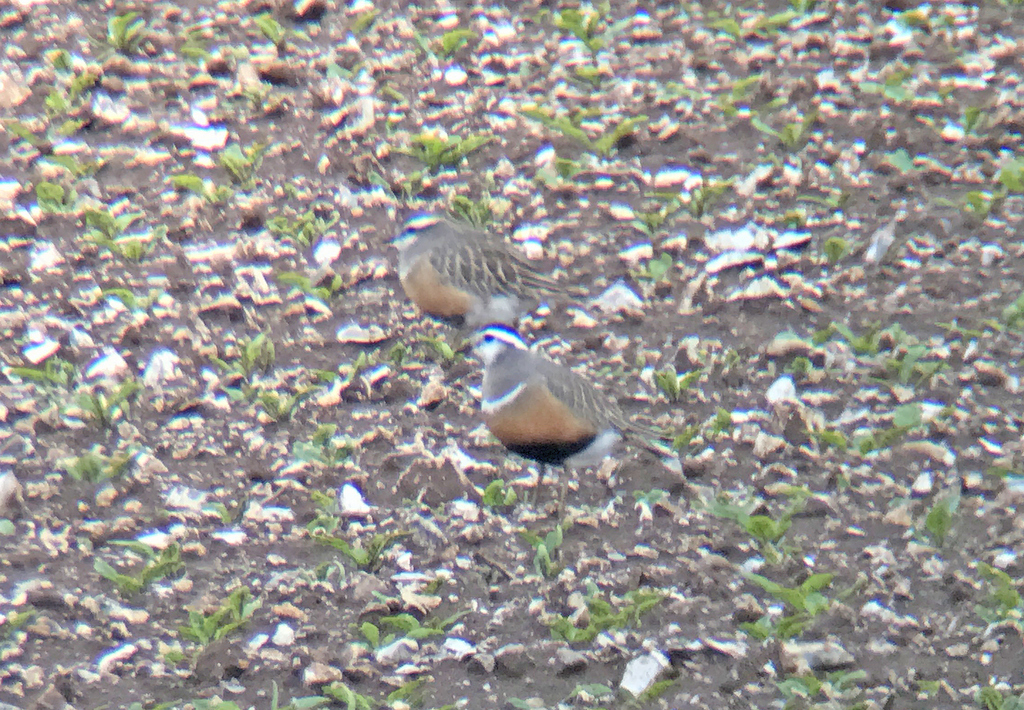
The Dotterel will probably be leaving here in the next few days, on their way up to Scandinavia for the breeding season. Otherwise, there were a couple of Red-legged Partridges and a couple of Brown Hares in the field too. We disturbed some small moths from the grassy verge while we were standing here, more Diamond-back Moths. As we had seen yesterday, they are continental migrants and appear to have arrived here in the last couple of days over from Scandinavia.
A Common Whitethroat was singing from one of the hedges nearby, but at first that was all we could hear. Then a Corn Bunting started singing from further up the road, so we walked up to look for it. We found it perched in the top of hedge, where we had a good look at it through the scope, while we listened to its song, not totally unlike the bunch of jangling keys with which it is often compared.
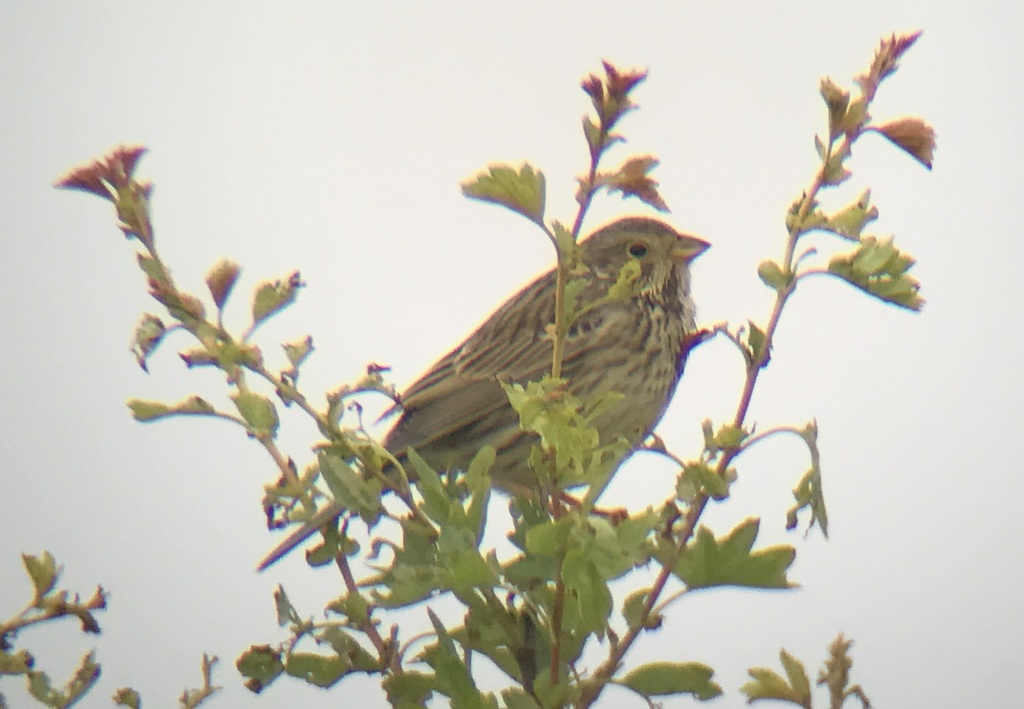
From Choseley, we wound our way west along the minor roads inland towards Holme. On the way, we found a couple of smart male Yellowhammers singing from the wires and flushed a couple more from the puddles by the road side. As we got out of the minibus at Holme, a Chiffchaff was singing from the top of a bush. We walked a short distance further up the track, where a Sedge Warbler was singing in a buckthorn bush in the reeds.
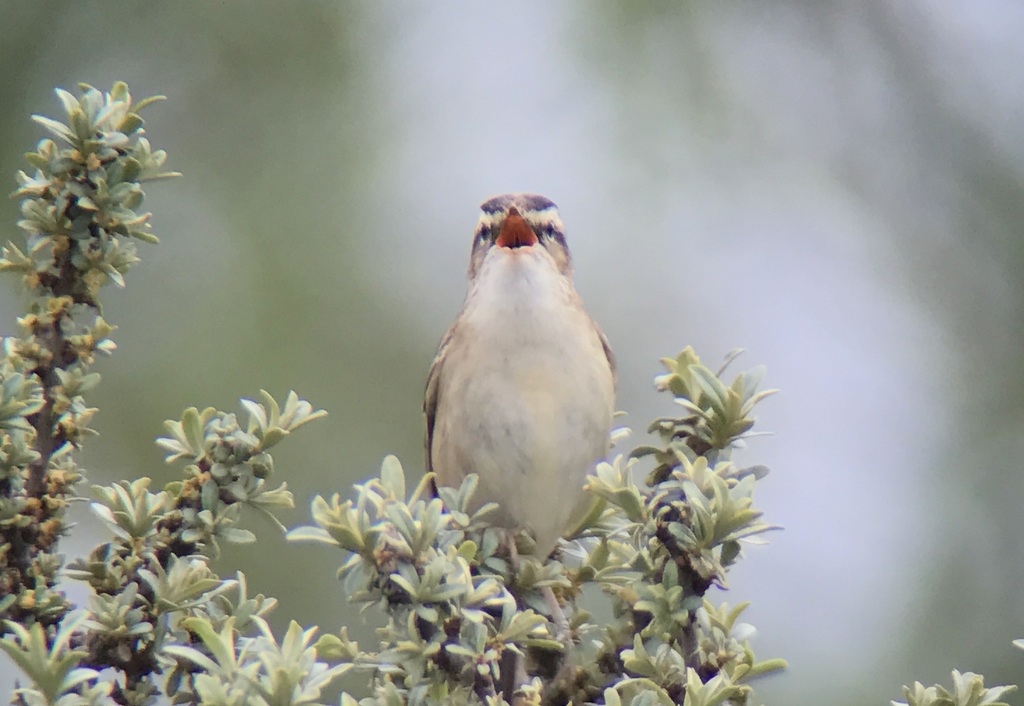
Up on the seawall, we walked back down to the old paddocks. A Common Cuckoo was singing in the distance, but seemed to be getting progressively closer. A couple of Common Whitethroats were singing from the bushes and a Cetti’s Warbler shouted at us as we passed.
A male Bullfinch flew over calling, but disappeared into the bushes before everyone could get onto it. Thankfully just a little further on we found first what was possibly another male, lurking deep in the hawthorns, and then the pair together, the bright pink male and browner female. A Robin was busy feeding a fledgling in the bottom of a small tree, but there was no sign of any obvious migrants fresh in here.
After a couple of distant flight views, the Cuckoo eventually came over close to us, so we had a much better view of it. Then a female appeared and we watched first one and then two males chasing it round through the trees, singing. A Turtle Dove flew over the paddocks but unfortunately didn’t stop, disappearing round the trees at the back.

Walking back, we went a bit further the other way to the start of the dunes. There had been a Whinchat earlier here, on the fence by the entrance track, but there was no sign now. We did see a couple of Lapwings in the short grass. Two Marsh Harriers were flying round over the grazing marshes beyond.
We headed round to Titchwell next. Another Bullfinch flew across the car park as we got out, and landed in the hedge, another smart pink male. There were a few Black-headed Gulls flying inland to feed overhead and we picked out our first Mediterranean Gulls flying over too, their pure white wingtips appearing translucent against the sky.
As we made our way out onto the reserve, we could hear Reed Warblers and Sedge Warblers singing in the reedbed. A couple of Reed Buntings were singing too, perched in the tops of the bushes in the reeds. We stopped to listen and after a few minutes heard Bearded Tits pinging a bit further along. We hurried up to where the calls were coming from and found a juvenile standing on a pile of dead reeds at the back of on one of the pools. It was a pale tawny brown, with black on the back and black lores, but lacking the ‘beard’ of the adult male.
After a minute or so, a male Bearded Tit flew in from further back and dropped down into the reeds. The juvenile made its way through the reeds to join it. The male worked its way round the margin of the pool, low down in the reeds beside the water, with the juvenile following behind it, waiting to be fed. Over the next ten minutes or so we had great views of them feeding and perched in the reeds.
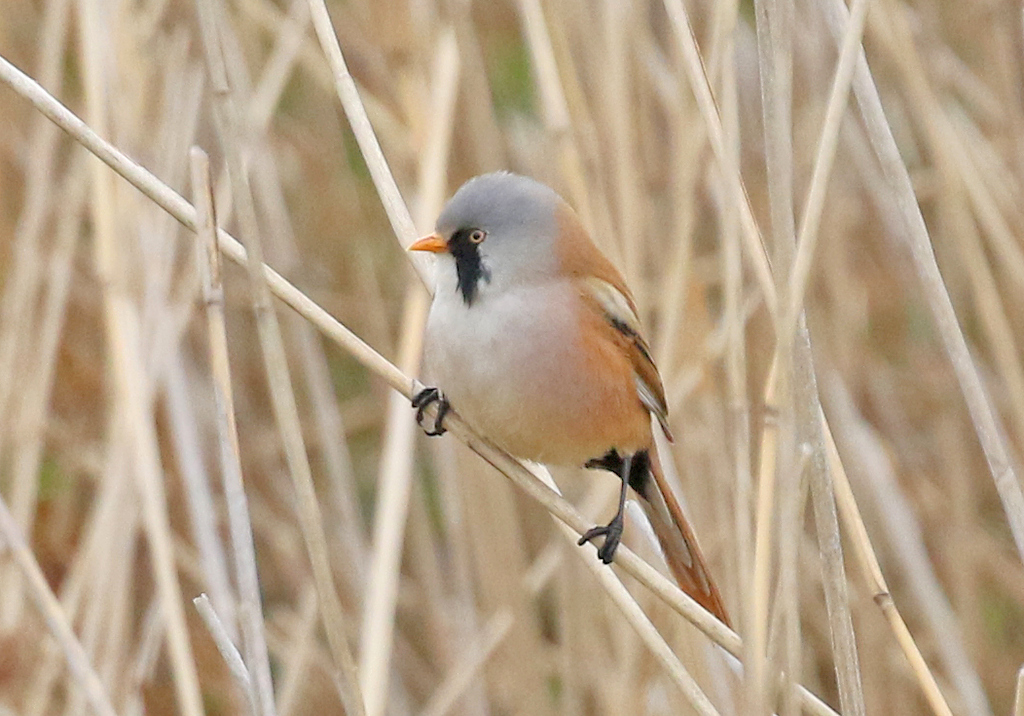
Several Common Swifts were zooming back and forth, low over the reedbed, occasionally coming over the path and passing just a foot or so over our heads at one point. With the grey, cloudy weather, they were hawking for insects low over the reeds. A couple of Marsh Harriers were up and down from the reeds too. On the other side of the path, a smart Grey Plover in breeding plumage, with black face and belly, was on Lavender Pool.
There were not many waders on the Freshmarsh today. Scanning from the west bank path, initially a lone Turnstone on the nearest island was the only one of note, with plenty of Avocets too further back. There were still a few ducks – plenty of Shelduck, a few Shoveler and Gadwall, and a single pair of Teal. There are still quite a few Brent Geese lingering, flying in and out from the saltmarsh. They should be heading off to Siberia for the breeding season soon.

The Freshmarsh now is rather dominated by gulls. We managed to pick out a rather distant Little Gull, but it was fast asleep over on one of the more distant islands. In between a couple of Black-headed Gulls, it was noticeably much smaller. A Common Tern was on the low brick island and through the scope we could see its slicked back black crown and black-tipped orange-red bill.
We had a closer view of the gulls from Parrinder Hide, and when we got in we saw there were now two Little Gulls, both immatures, first summers. One had acquired a largely dark hood, but the other still just had the dark spot behind the eye and dark cap. We also had good views of the Sandwich Terns gathered on the island from here, admiring their shaggy crests and yellow-tipped black bills through the scope.
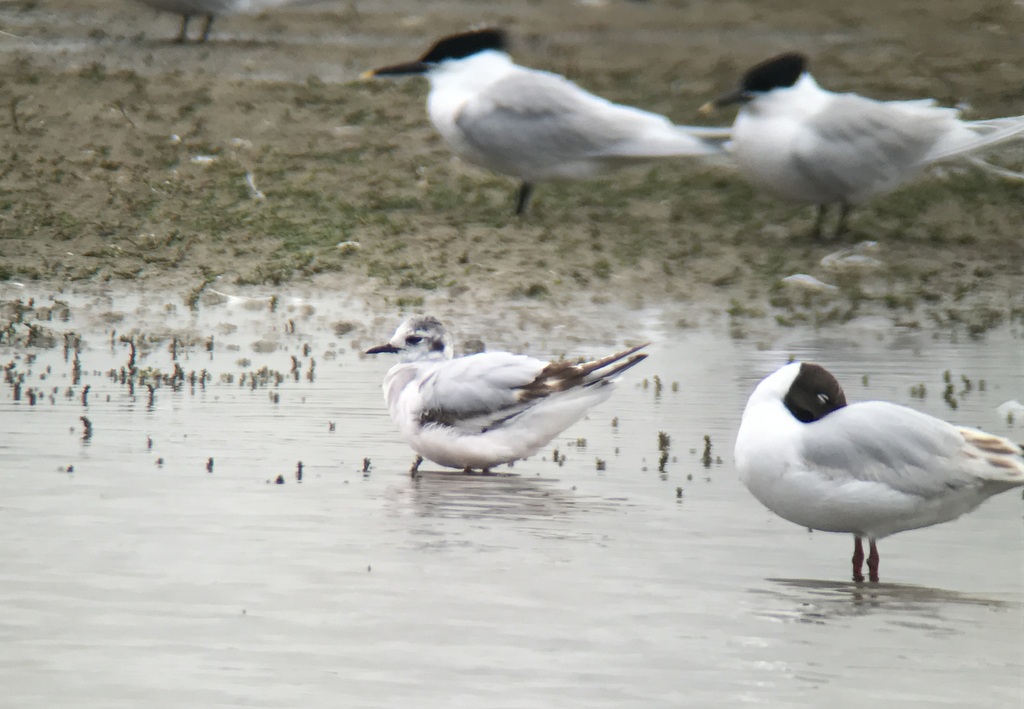
The Black-headed Gulls have largely taken over the fenced off ‘Avocet Island’ and are busy nesting now. Looking through them throng, we could see a good number of Mediterranean Gulls in with them, their jet black hoods making them stand out. Through the scope, we could see their brighter red bills and white wing tips too.
Two Common Sandpipers had now joined the Turnstone we had seen earlier and we picked up a Little Ringed Plover on the island to the right of the hide. It ran straight over towards the near edge where we could get a really clear view of its golden yellow eye ring in the scope. There was a nice pair of Avocets just below the hide too – always nice to watch them at close quarters.
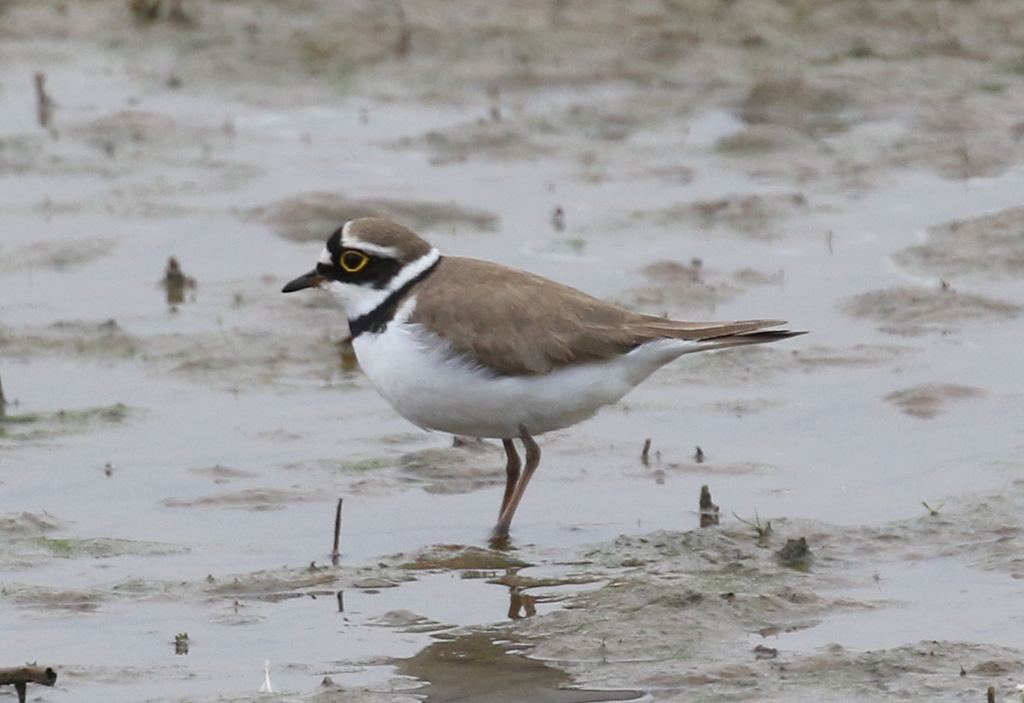
We had a quick look at Volunteer Marsh from the other side of Parrinder Hide. There were several more Grey Plovers over towards the back, but otherwise nothing else of note. There were no more different waders on here in the tidal channel from the main path either.
The island on the non-tidal ‘Tidal Pools’ held just one Oystercatcher, so we presumed there would be more waders out on the beach. The tide was out but there were several people down on the sand digging around the exposed mussel beds and someone fishing away to the west. Consequently, there were very few waders today – just more Oystercatchers and a few Turnstones feeding on the mussel beds. It was rather misty offshore, but we did manage to find a few Great Crested Grebes on the sea out towards Scolt. It started to spit with light drizzle now, so we decided to head back for lunch – it was already after 1pm and we were all getting hungry!
After lunch, we walked round on Fen Trail for a quick look at Patsy’s Reedbed. As we passed Fen Hide, one of the two Little Gulls was now hawking over the reedbed. There were a few people looking for the Turtle Doves on the Tank Road, but there was no sign of them. They are only coming in and out very irregularly at the moment.
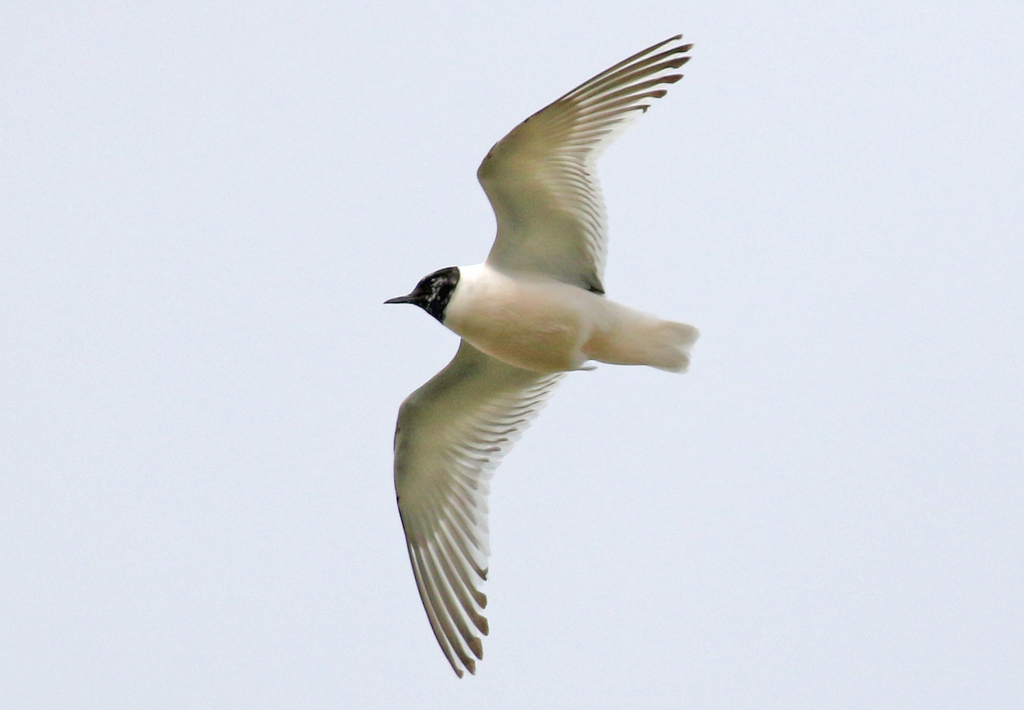
There were quite a few birds on Patsy’s Reedbed, mostly Greylags and gulls. Five Red-crested Pochards were over by the reeds at the back, including several smart drakes with their orange punk haircuts and bright coral-red bills. A Little Grebe was diving nearby. A Little Ringed Plover was working its way along the near shore away from us.

A few Mediterranean Gulls had come in to bathe with the Black-headed Gulls, giving us another opportunity to practice our new gull identification skills. Several Marsh Harriers circled up over the reeds. It had brightened up now, and looking out over the reedbed we could see that the Swifts had now gone, moved higher chasing after the insects. We had one more place we wanted to visit this afternoon, so we made our way back to the car park, stopping on the way to watch a Song Thrush smashing a snail on the ground.
As we arrived at Wells and got out of the minibus, a Barn Owl flew across the field behind us. It was carrying a vole, presumably heading off inland to feed a hungry brood somewhere. There were lots of birds around the pools here. Looking on one side of the track, we could see three Greenshanks down at the far end. There were lots of Lapwings and Avocets, both with young. A pair of Avocets with three fluffy chicks were leading them through the grass, producing lots of squabbles with the Lapwings which had their own youngsters hidden here. A Grey Heron was lurking ominously at the back of the pool.
On the other side of the track, we could hear Wood Sandpipers calling. Scanning across, we counted at least six feeding in and out of the clumps of rushes. In the scope, we could see their white-spangled upperparts and well-marked pale supercilium. There had been a couple of Temminck’s Stints reported here and we eventually found them lurking in the vegetation on one of the islands. They kept popping up in different places and there appeared to be more than two, but it was hard to see how many until they flew round, and we could see four Temminck’s Stints all together.
There were lots of other waders too – including a couple of Common Sandpipers, and two or three Little Ringed Plovers. We watched two Common Snipe on the edge of the rushes, one of them fluffing itself out and cocking its tail at something nearby in threat display. Several Black-tailed Godwits were feeding further back, with one or two in rusty breeding plumage.
It was a nice place to finish the day, in the sunshine watching all the waders. But there was a gory end to come yet. The Grey Heron we had seen earlier had been stalking a brood of Mallard ducklings. We watched as it flew in and grabbed one, swallowing it whole. It retreated to the bank for a bit, then came back out and grabbed another one – the Mallards were squabbling, with five or six drakes chasing after the female and distracting her from watching the ducklings. As we packed up to leave, we saw the Grey Heron grab a third duckling. A reminder that nature is red in tooth and claw! Just the natural way of things.
















